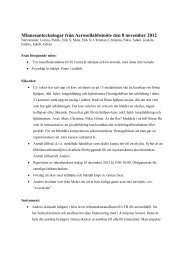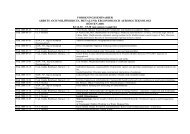ESTIMATING CLOUD DROPLET EFFECTIVE RADIUS ... - CAST
ESTIMATING CLOUD DROPLET EFFECTIVE RADIUS ... - CAST
ESTIMATING CLOUD DROPLET EFFECTIVE RADIUS ... - CAST
- No tags were found...
You also want an ePaper? Increase the reach of your titles
YUMPU automatically turns print PDFs into web optimized ePapers that Google loves.
<strong>ESTIMATING</strong> <strong>CLOUD</strong> <strong>DROPLET</strong> <strong>EFFECTIVE</strong> <strong>RADIUS</strong> FROM SATELLITE REFLECTANCE DATAModified Exponential Approximation___________________________________________________________________________________________________Besides the measured reflectance in the visible and NIR, data on solar and satellite zenithangles and azimuth angles are provided for every scene pixel by MODIS. These data are themain inputs in the model described in the previous section. With the reflectance and viewinggeometry given by MODIS, a few more input parameters are required. The ground surfacealbedo for every pixel can be received as a MODIS product. Since the clouds are blocking thesurface, the ground surface albedo must be taken from another date with clear sky conditions.In early May when vegetation period is at its beginning, ground surface albedo may varysignificantly from one week to another, depending on the vegetation cover and the soilmoisture content. Therefore it is at this time of the year difficult to produce accurate values ofA g . However, the ground surface albedo has a relatively small influence on the final result,and for simplicity, standard values of A g in the two wavelengths is set for all pixels coveringland. Typically, surface albedo for bare soil is about twice as large for wavelengths > 0.7 µmthan for wavelengths < 0.7 µm (Post et al., 2000). For the two wavebands λ = 1.6 µm and λ =2.1 µm the ground surface albedos are set to 0.2 and 0.4 respectively. These values areaverage values of surfaces with forest cover or bare soil (Ahrens, 2003, p. 46). The surface isalso assumed to be Lambertian, i.e. the reflectance is equal in all directions.The asymmetry parameter g and the single scattering albedo ω 0 must be known, but they areboth depending on the effective radius. The asymmetry parameter is defined in Eq. (2.4) butsince the Legendre polynomials and expansion coefficients are not known, g can instead befound by following equation:1−g = 0.12 + 0.5 3−2( kr e) − 0.15κre(2.42)where k = 2π /λ and κ = 4πχ /λ. χ is the imaginary part of the refractive index of water(Kokhanovsky et al., 2003; Kokhanovsky et al. 2005a) and set to 1.64⋅10 -8 and 4.00⋅10 -4 forχ 1 and χ 2 respectively (Kokhanovsky, 2006, p. 259; Kokhanovsky et al., 2006, unpublished).Kokhanovsky and Zege (1995) also present a parameterisation of the absorption andextinction coefficients k a and k e which are used to derive the single scattering albedo in theNIR (in the visible ω 0 is assumed to be 1):ka**= kaCv, kekeCv= , (2.43)where⎛ ⎞∗ 1.5⎜1.1ke =1 +(2.44)re⎝( ) ⎟ 3kr2 /e ⎠k∗a( 1−κr)5πχ ⎛ ⎛⎞⎞e ⎜⎡⎜8λ⎤=1 + 0.34⎟⎟1 − exp⎢− ⎥λ⎝ ⎝ ⎣ re⎦⎠⎠(2.45)and C v is the volumetric concentration of droplets. However, since 1 – ω 0 = k a / k e (Eq. 2.11)ω 0 is given by*kaω0= 1−(2.46)*ke18




